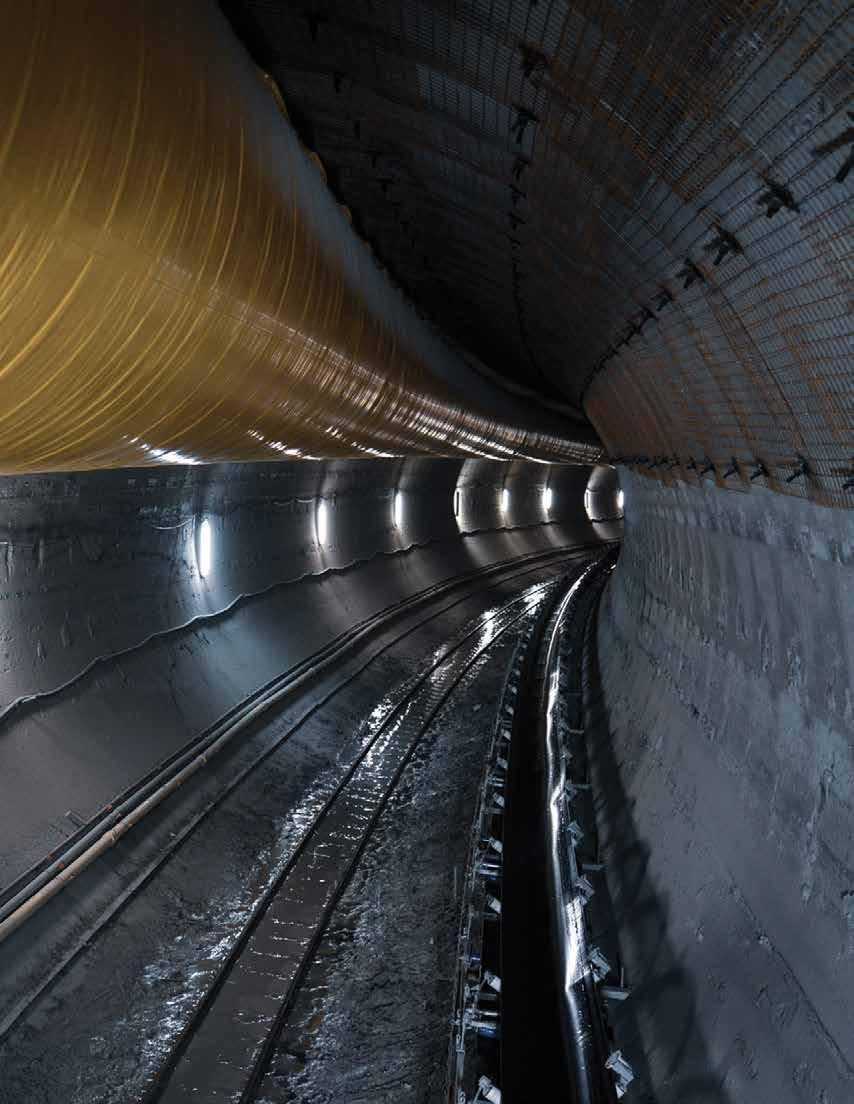
Setting records and bringing innovation to the industry. Connections The Official Southland Magazine SUMMER 2023 HISTORY in the making MILL CREEK TUNNEL HISTORIC INFRASTRUCTURE
feature story
SPEND
Building Great Things. For more than 120 years, hard-working, honest, innovative people have been forming what has become Southland. We combine the strengths of six subsidiaries that share a dedication to delivering critical infrastructure projects that improve the environment and lives of those around us. Across all 50 states and more than 60 countries, you can find the mark of our legacy.
Throughout Southland’s history, we have laid roads that connect our nation, constructed pipelines to carry water across vast regions, built some of the world’s most iconic structures, and bored tunnels through some of the world’s most challenging geology. We deliver projects that shape our landscape and create sustainable solutions for future generations.
Our values create the foundation on which we operate. A passion for finding solutions, a dedication to safety, and care for our employees – these are the things that make Southland a family of companies. The people who chose to work here are our most valuable asset and provide the essential link between challenges and answers. As a values-based firm, we invest in our team and encourage innovation, creativity, personal and professional development, and teamwork.

Johnson Bros. Corporation | Oscar Renda Contracting Southland Contracting | Heritage Materials Mole Constructors | American Bridge Company Southland Connections is a bi-annual magazine issued by Southland. To subscribe, visit: www.southlandholdings.com Copyright 2023 by Southland Inc. All rights reserved. Southland Connections and the Southland logo are service marks of Southland Holdings Inc. We are an equal opportunity employer. To contact us, visit: www.southlandholdings.com
Contributors: Michele Cunningham-Scott, Gabrielle Henderson, Lydia Stephens, Brian Gettinger, Kwadwo Osei-Akoto, Tom Charles
letter from

MAKING FUTURES BRIGHT
We can’t think of a better way to launch our combined company magazine, Southland Connections, than with this issue’s incredible projects and features. All the stories you will read have one thing in common – they are “Building Great Things” for the people and communities we live and work in. It’s the Southland way. We go the extra mile; we run at problems and find a path to success.
Our path to success starts with our Protect My Family safety culture. We have celebrated some impressive safety milestones this year, including Ashbridges Bay Outfall Tunnel project achieving over one million consecutive manhours without a lost time incident. Brightline Zone 4, Phase Two project with nearly 600,000 safe manhours and the SELA 26 Canal Widening has over 1000 consecutive days without incident. These are just a few examples of how our teams ensure everyone goes home safely daily.
The Mill Creek Drainage Relief Project in Dallas, Texas, is another perfect example of how we find a path to success. Southland Contracting | Mole Constructors JV has completed the boring of this history-making tunnel project in our corporate hometown, ultimately providing a much-needed stormwater relief outlet for downtown Dallas. Read about this impressive project on page six.
Our Johnson Bros. team is at the forefront of innovation and automation with the construction completion of the SunTrax Connected/Automated Vehicle Test Facility in Polk County, Florida. This
Frank Renda Southland President & CEO
state-of-the-art facility is dedicated to the research, development, and testing of emerging transportation technologies and is the first of its kind.
Finally, I am proud to share with our readers more about Southland as a public company through a Q&A with our CFO, Cody Gallarda, and Director of Corporate Development & Investor Relations, Alex Murray.

In closing, we would like to thank the nearly 3,000 employees across North America and the Caribbean that are building some of the most critical infrastructure projects for our communities. Your dedication to constructing quality and safe projects is what makes Southland great.
We hope you enjoy learning more about our projects and people in this issue. Thank you for Protecting Our Family every day.
Tim Winn EVP, Chief Operating Officer
Rudy Renda EVP, Chief Operating Officer Cody Gallarda EVP, Chief Financial Officer
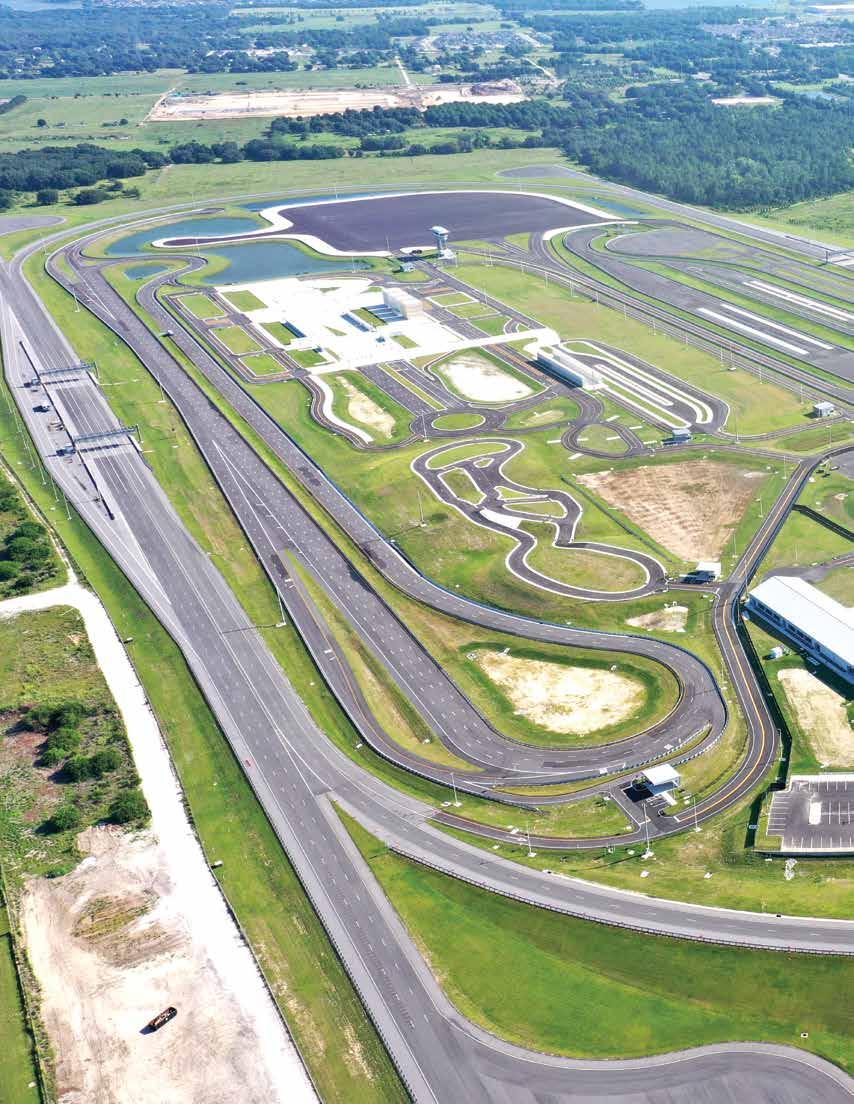
Suntrax Connected/Automated Test Facility
project completion aerial.
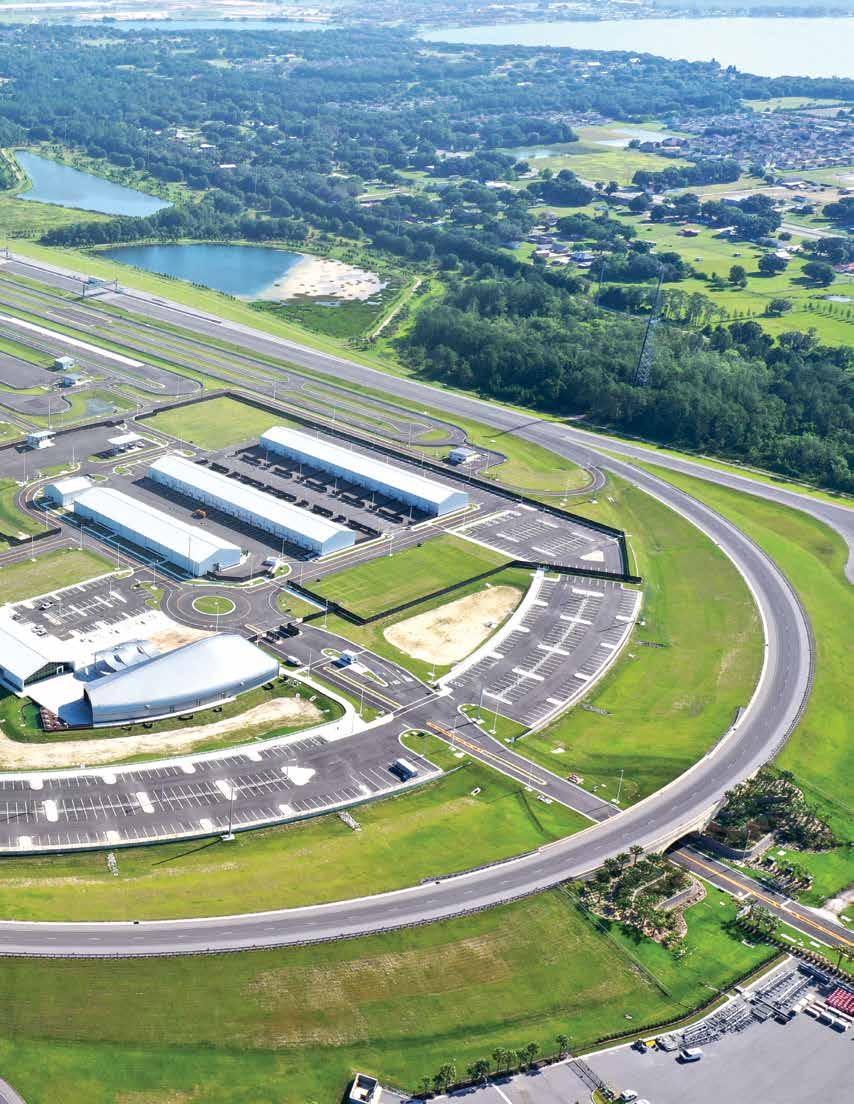
table of CONTENTS 6 MILL CREEK TUNNEL History in the Making 13 MENTAL HEALTH IN THE INDUSTRY Awareness & Impact 14 EMPLOYEE SPOTLIGHT BUILDING HIS LEGACY Kwadwo Osei-Akoto 16 QUEENSBORO BRIDGE Updating an Iconic New York Structure 18 HISTORIC INFRASTRUCTURE SPEND 26 SUNTRAX CONNECTED Innovation & Automation 30 FLASH BACK Brent Spence Bridge 32 SAFETY IN ACTION 33 CURRENT CONTRACTS INVESTOR RELATIONS Q&A 23 COUNTING BLESSINGS the Southland Way 34
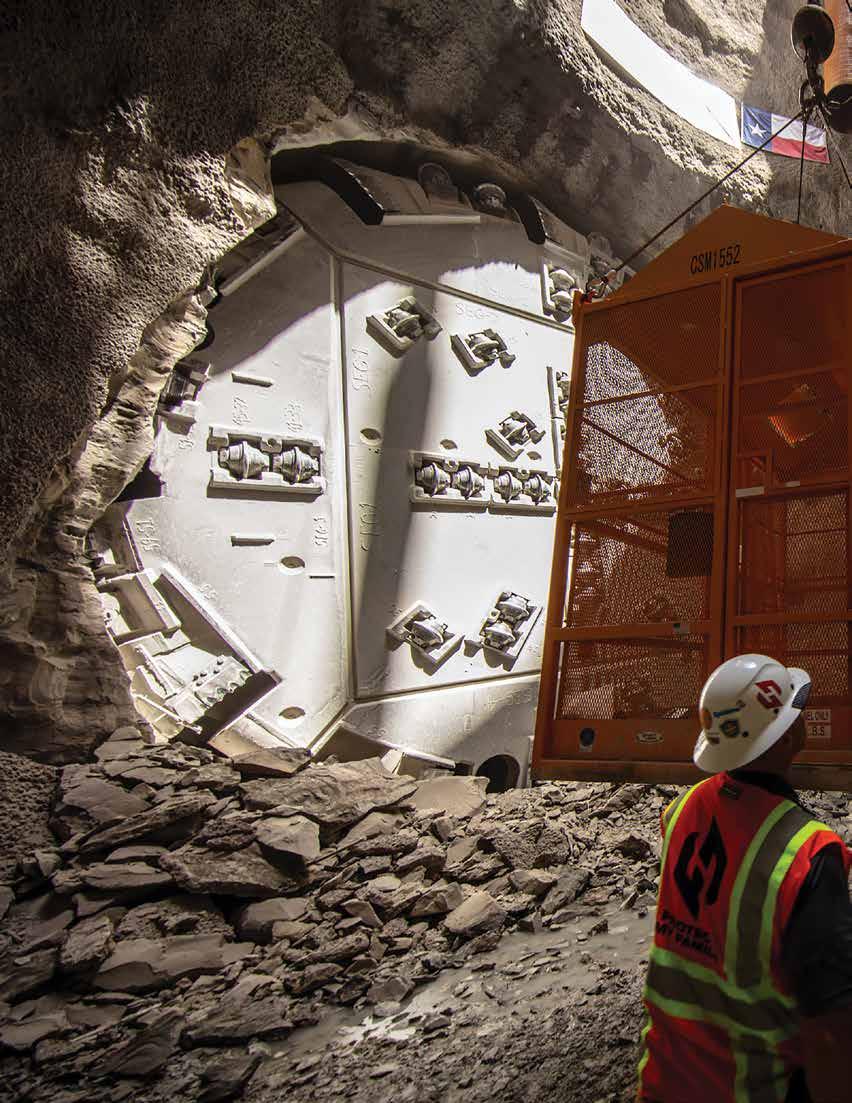
6 CONNECTIONS
Big Tex holed through right on target to cap off the the end of the tunnel excavation milestone celebration.
MILL CREEK Drainage Relief Tunnel Project

Mill Creek Tunnel, being built by the Southland/ Mole joint venture for the City of Dallas, has moved into concrete lining operations after one of the largest hard rock tunnel boring machines (TBMs) ever used in the United States completed mining in July 2022. “Big Tex,” as the TBM was nicknamed, began mining with a 37.5 ft diameter before converting to a 32.5 ft diameter about 2 miles into the 5-mile-long excavation.
The 5-mile-long, 37.5 ft to 32.5 ft in diameter tunnel, has five large intake structures along its route to intercept existing storm sewers.
7 Summer 2023 cont...
CONTRACT VALUE
$212,000,000


March 2018
December 2025











100-150 individuals depending on current activities.
1,500,000 CY from Main Tunnel alone. Total job would reach approximately 2,000,000 CY of material excavated.
130,000 CY of concrete placed in Main Tunnel alone. Total job would reach approximately 170,000 CY of concrete.
The project has received recognition from all corners of the engineering and construction community, including earning a “TECHNICAL INNOVATION OF THE YEAR” award from the International Tunneling Association (ITA), for Unprecedented In-Tunnel Diameter Conversion, of the Largest Hard Rock TBM in the U.S.
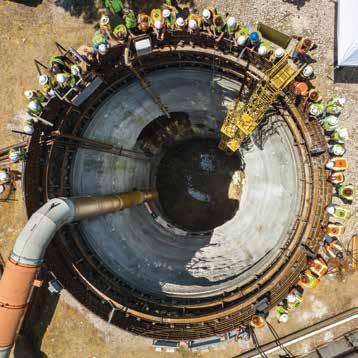
Drainage issues surrounding the Mill Creek Tunnel were originally identified in 1970. Major flooding events through the 1990s and 2000s, including a major storm in May 1995 that flooded the Baylor Hospital emergency room and closed Interstate 30, reinforced these needs.
The 5-mile-long, 37.5 to 32.5 feet in diameter tunnel, has five large intake structures along its route to intercept existing storm sewers. These intake structures will prevent flooding along the tunnel alignment, and the tributary storm sewers that will connect to the tunnel. Once flow is collected, the tunnel will direct flow east to an outfall structure along White Rock Creek, where it will be released, avoiding flood damages in east urban Dallas.
Once complete, the tunnel will function hydraulically by gravity as an inverted siphon. Since the elevation of the outlet structure is lower than the intake structures, water that enters the tunnel will fall down the 100 to 150-foot-deep intake shafts, and be carried through the tunnel. It will then rise out of the 100-foot-deep outlet structure entirely by gravity. Although the Mill Creek Tunnel is larger than its predecessors, it will function similarly to the San Antonio River Tunnel built by the USACE in San Antonio in the late 1990s, and the Waller Creek Stormwater Tunnel built by the City of Austin in the 2010s. Both projects have been credited with significant flood damage reduction.
The Mill Creek Tunnel is now an example for future stormwater tunnels, including efforts in Houston to mitigate flooding after Hurricane Harvey.
CONNECTIONS
NTP ESTIMATED COMPLETION PERSONNEL EXCAVATED MATERIAL CONCRETE
8
The Mill Creek Tunnel is now an example for future stormwater tunnels, including efforts in Houston to mitigate flooding after Hurricane Harvey.
5 TOTAL MILES OF TUNNEL through Austin Chalk Formation (Limestone).
2 miles at 37’-7” Excavation with 35’-0” Finished Concrete Liner.
3 miles at 32’-7” Excavation with 30’-0” Finished Concrete Liner. Excavated by method of TBM. Support consisted of wire mesh, 14” long rock bolts, and steel channel as necessary.
8 TOTAL SHAFTS ranging from 100VF to 180VF in depth, and ranging from 14’ diameter to 45’ diameter – includes 1 outfall shaft, 5 drop shafts, and 1 dewatering shaft. All consisted of liner plate/ring beams through the overburden, and rock bolts, wire mesh, and shotcrete through the rock. Excavated conventionally with excavators and hammers/breakers. All to be finished with Cast in Place (CIP) Concrete Liner.

6 TOTAL LATERAL TUNNELS connecting to the Main
tunnel, ranging from 50 LF to 500 LF in length, and ranging from 12’ to 25’ diameter (horseshoe shaped excavations). All initial support consisted of wire mesh and rock bolts. Excavated conventionally with roadheader or excavators with hammer/breaker (horseshoe shaped excavation) All to be finished with CIP Concrete Liner (circular finish).
STRUCTURES
4 Large Intake Structures designed to intersect with the drop shafts to create a vortex.
4 large Junction Boxes constructed on live storm systems. Mega-Inlet structures. CIP Inlet structures.
SURFACE IMPROVEMENTS
4000 LF of storm system improvements (Concrete Box Culverts – 9x9, 10x10, 12x12, Concrete Pipe, Storm Inlets, etc).
5000 LF of water line improvements.
5000 LF of sanitary sewer improvements. Concrete and Asphalt Paving. Sidewalks, curb and gutter, walking trail improvements. Traffic Signals, residential street lights, signage.
9 Summer 2023
cont...
Man basket lowering crews down 140’ feet into the retrieval shaft of the project.

10 CONNECTIONS
Like many large, complex projects, the Mill Creek Tunnel required innovation by the construction team due to the sheer scale of the project. The TBM provided by Robbins, nearly a football field in length, was fully assembled on-site for the first time, with parts being sourced globally to Southland/Mole’s main work site in east Dallas. This method expedited TBM delivery, assembling, mining start, and significantly reduced the cost to mobilize such a large piece of equipment. The TBM was fully assembled at the surface, then lowered in sections, into the tunnel with a specialized heavyweight crane.

The in-tunnel diameter change was an industry first, and required portions of the cutterhead to be removed from the machine and transported through an adit connection. All of this was done without a disassembling chamber.
Because of the expansive tunnel diameter, the TBM produced a colossal amount of muck that was conveyed from the machine to the surface. At 37.5 feet excavated diameter, each foot of excavated tunnel produced over 60CY of spoils to handle on the surface (Including fluff-factor for the soft rock. The tunnel muck required 200 trucks per day), and had days reaching 500 truckloads when production was at capacity.
The mining operation averaged approximately 50 LF/day once all downtime was considered. The best day of production achieved 170 LF with the best week of production reaching approximately 600 LF.

11 Summer 2023
TBM, named Big Tex is 220 Feet long, making it the largest TBM to ever be constructed in Texas.
Since this is a two-pass tunnel where the mining and the tunnel lining are completed in separate activities, the focus of the tunnel has now shifted to concrete lining operations, which are expected to be completed in 2025. The concrete lining, which consists of 15-inch-thick unreinforced concrete, will require 130,000 cubic yards for the 5-mile length of the tunnel, or 14,400 concrete truck loads. Placement of the concrete requires careful coordination by the construction team to ensure concrete quality meets the project specifications. Large agitating hoppers are used to move the concrete miles into the tunnel from the shaft to the placement location. These hoppers can each hold 13 CY weighing approximately 60,000 lbs when fully loaded. Once the hoppers reach the placement location, concrete is pumped into a large custom tunnel formwork system, which places the concrete in lengths up to 100 LF (500 CY).


Stay tuned for more project updates as concrete lining wraps up and the project goes fully online in 2025.


CONNECTIONS
SLND COMPANIES current contracts
PROJECT NAME LOCATION
Kirkman Road Extension Orlando, FL
Turnpike Mainline Widen E8Q79
Mill Creek Drainage Relief Tunnel
US175 Dallas County
ARDOT IH-30 Saline County
SR5 & SR11 Jupiter Project
McCluggage Bridge Project
Lake Worth, FL
Dallas, TX
Dallas, TX
Benton, AR
Jupiter, FL
Peoria, IL
LADOT I-10 TX State Line E Lake Charles, LA
IH-10 Jefferson County
City of Dallas 22-23 Resurfacing Project
Winkler County Road Project
Beaumont, TX
Dallas, TX
Kermit, TX
Ashbridges Bay Outfall Tunnel Toronto, ONT
Atoka Raw Water Pipeline
Coffee Creek WRRF Expansion
Ada, TX
Edmond, OK
Ashburton Reservoir Tanks Baltimore, MD
East Side WTP Flocculation & Sedimentation Basin Improvements
Northwest Water Treatment Plant Expansion & Upgrades
Dallas, TX
Leland, NC
Druid Lake Finished Water Tanks Baltimore, MD
Brightline Zone 4 Phase II
SELA 26 Canal Widening
SR80 Bascule Bridge Palm Beach
Schoharie Reservoir Low Level Outlet Tunnel
West Palm Beach, FL
New Orleans, LA
West Palm Beach, FL
Gilboa, NY
RM 652 Culberson County Oria, TX
DWU Elm Fork 72in Water Main
Romeo Arm Lining Segment 5
SR55(US 19) Recon at Northside
El Paso Water Phase 3
US27 D4 Resurfacing
US 60 Parmer County
US 285 Reeves County
El Paso Water Phase 2
New Westminster Interceptor
Granville Bridge Connector
North End Sewage Treatment Plant
Queensboro Bridge Upper Deck
Lighthouse Point
SR520/Montlake to Lake Washington
US-60
Elm Fork WTP Filter Complex
West Gates DIW Pond Expansion
Arcadia Intake
Connors Creek Sewer Rehab
East Haddam Swing Bridge
Wolf Creek Dam Spillway Gates Replacement
Center Hill Dam Spillway Gates Replacement
Bridge Replacement Table Rock Lake
District 1 Middle-Mile Broadband Network
LADOTD Nelson Road Bridge & Extension
Dallas Maintenance
US-19 Pinellas County
Shands Bridge over St.John River
ENMWUA-Clovis Finish Water Line
* Bolded projects awarded 2022 to current.
Dallas, TX
Sterling Height, MI
Eugene, FL
El Paso, TX
Palm Beach County, FL
Bovina, TX
Pecos, TX
El Paso, TX
New Westminster, BC
Vancouver, BC
Winnipeg, MB
New York, NY
Eleuthera, Bahamas
Seattle, WA
Smithland, KY
Dallas, TX
Denver, CO
Acadia, OK
Detroit, MI
East Haddam, CT
Lancaster, TN
Jamestown, KY
Branson, MO
Northern California, CA
Lake Charles, LA
Dallas, TX
Clearwater, FL
Jacksonville, FL
Clovis, NM
Summer 2023 13
RELATIONS INVESTOR
Southland has gone public! In real world terms, we asked our CFO, Cody Gallarda, Director of Corporate Development & Investor Relations, Alex Murray, a few questions about what this all means.
WHAT DOES IT MEAN FOR A COMPANY TO “GO PUBLIC”?
A company becomes a public company when it transitions from being privately owned to having its shares available for anyone to purchase on a stock exchange. Shares, also known as stock, of the company can be purchased by any individual or institutional investor. Southland’s stock is listed on the New York Stock Exchange. Being listed on an exchange provides a public market where investors can buy and sell shares, and own a part of the company.



WHAT ARE YOU EXCITED ABOUT & WHAT ARE SOME OF THE BENEFITS OF BEING A PUBLIC COMPANY?
There are several benefits from being public that can help drive growth and value, including increased visibility and public recognition, which can enhance brand, reputation, and credibility. Being public can also help us grow more seamlessly, and give employees more opportunities to pursue their professional goals as the company grows. We are also excited about the opportunity for employees to own Southland stock, and potentially personally benefit from long-term company success.
company, but now as a requirement, it

14 CONNECTIONS
is important to keep critical information (bidding info, new project awards, financial performance, etc.) confidential.
WHAT MAKES A COMPANY’S STOCK PRICE FLUCTUATE SO FREQUENTLY?
There are numerous factors that can impact a company’s stock price. These include, but are not limited to:
1. Company-specific news and performance: The company’s financial reports and management’s commentary about the outlook for the business can impact on the price. Company news about new awards, mergers and acquisitions, and partnerships can also impact on the stock price.

2. Macroeconomic drivers: Broader economic conditions and trends can affect the stock price. Factors such as interest rates, inflation, GDP growth, and geopolitical events, can impact investor sentiment and market outlook, leading to fluctuations in the stock price.
3. Investor Sentiment: Investor sentiment, or market psychology, plays a crucial role in stock price movements. Sentiment can be influenced by factors like investor confidence, risk appetite, market speculation, and trends. Positive sentiment can drive the price higher, while negative sentiment can result in declines.
It’s important to note that stock price fluctuations can be influenced by a combination of these factors and can sometimes occur due to market speculation, rumors, or irrational behavior. Additionally,
stock markets are inherently volatile, and short-term price movements can be unpredictable. For these reasons, it is vital that we all remain focused on what we can control and strive to be the best at what we do. We, as a company, need to remain focused on the long-term goal of safely constructing profitable projects.
WHAT IS “SOX”? HOW DOES IT AFFECT THE COMPANY AFTER GOING PUBLIC?
The Sarbanes-Oxley Act (SOX), officially known as the Public Company Accounting Reform and Investor Protection Act of 2002, is a United States federal law, enacted in response to major corporate accounting scandals, most notably the Enron and WorldCom scandals. It was named after its sponsors, Senator Paul Sarbanes and Representative Michael Oxley. SOX applies to public companies and Southland will have to be SOX compliant. Boiled down, SOX requires us to have documented processes that we follow, and we will be audited on those processes to prove we’re doing what we say we do.
The most significant impact of SOX on Southland will primarily revolve around enhancing internal controls over financial reporting. As a privately held company, Southland has already implemented numerous internal controls, such as our monthly job cost reports and calls, invoice approval, capex approval, etc. While there will be additional requirements, many of our existing processes will remain unchanged.
Summer 2023
15
The first thing that strikes you while talking with Kwadwo Osei-Akoto, are the rich warm tones of Africa in his voice. Tones, that seem to permeate all aspects of the man, his work and his life.
RESOLVE
The Early Years
Growing up in Ghana, a young Kwadwo first dreamed of being a pilot, though early on, this dream was put to rest when his vision was found to be less than 20/20, an apparent requirement for piloting. As his mother was the resident midwife to his village, and surrounding villages, Kwadwo found himself frequently in the delivery rooms, being coached and schooled by his mother for a career in medicine. By age 15, Kwadwo knew beyond a shadow of a doubt, that he absolutely did not wish to be a doctor. Instead, the dream of being an engineer had begun to grow in him. This dream was to become a reality – through sheer resolve, passion, and a belief that he could. A character trait instilled in him at a young age by his grandmother. Kwadwo recalls her advice “When my siblings or I would ask my grandmother for help with a problem, she would ask ‘What’s the problem? Did someone die? If not, it can be solved. Only death cannot be solved’. ‘I’ve taken that to heart.”
spotlight
building his legacy
Kwadwo Osei-Akoto, P.E.
SOLVE Planting the Seed
Kwadwo firmly believes in sharing his knowledge and experience with AB employees. Something he is well positioned to do with over 38 years of experience in complex bridge rehabilitation. “Mentoring is important. We must get things done, and I’m trying to instill the need to train young people to be tough. We can’t wait a few days – Challenges can always be expected. You have to be flexible and solve problems.”
RESILIENCE
From Ghana to New York City
Many miles and years away from that first dream of being a pilot, Kwadwo landed in NYC at the tender age of 19 – resolved to study engineering and fulfil his dream. After successfully graduating from Lafayette College in Easton, PA in 1984, Kwadwo went on to design bridges before joining American Bridge in 1989, where he would continue to grow and rise through the ranks.
Working in NYC, Kwadwo has been privileged to have seen many of NYC’s historic and storied bridges up close. “Not many people have had that chance,” says Kwadwo, expressing how fortunate he feels to have seen so much of the city construction, including the subway.

16
CONNECTIONS
“NYC is one of the toughest places to work in. Failure is not an option on any job I have. One has to be resilient. Especially when working on a bridge that was built 100 years ago. If you have to change the plan, you do it!”

LEGACY Growth, Guidance and Surprises
Kwadwo and his wife and high school sweetheart Joyce, married after years of maintaining a long-distance connection. “She was living in London, and we talked from time to time. Then she moved here. Since then, we have had three children.” While Kwadwo wanted his children to pursue engineering, much like his mother had wanted him to follow medicine, his children had their own ideas. Although Kwadwo proudly acknowledges having had a hand in guiding his daughter into nursing. His two sons however chose careers in IT, a decision he is not unhappy with.
Kwadwo then announced with some excitement that his daughter is expecting, and that he is to become a grandfather in July, but is firm that he doesn’t want to know the gender, preferring the surprise. “I never knew the gender of any of my children,” he mused fondly, “till the moment they were born.”
A MESSAGE

When asked what qualities he most admires in people and what message he would pass on, Kwadwo responded easily, “Honesty, being a team player, working hard for what you want, and believing.” He explained “You must be interested in what you choose . . ., focus, be persistent, and not give up. Growing up in a third world country, I learned to not give in. To overcome challenges with a smile, a positive attitude and gratitude. Believe and you will achieve. ”
HOBBIES GOLF & POLITICS
“Golf has become a passion, and if I have any free time, I would rather play golf than do anything else.”
“I like to read about politics. I’ll take politics any day. It doesn’t matter whether it is Republicans or Democrats. I want to know what other people think about the issues of the day.”
GREATEST ACHIEVEMENT
“I’m most proud that I have been able to raise my kids as I wanted to.”
“ Summer 2023 17
“You must be interested in what you choose . . ., focus, be persistent, and not give up.”
Queensboro
American Bridge crews are to start on Phase 3 of the Queensboro Bridge deck replacement project. They secured the project in 2018, and are looking to deliver the completed project by Summer 2024.

BRIDGE
American Bridge (AB) has a long history of building or retrofitting some of the most complex and ionic bridges in the New York City Area, and are currently half-way through the replacement of the upper roadway of the Ed Koch Queensboro Bridge for the New York City Department of Transportation. The $300 million rehabilitation project spans 1 1/4 miles connecting the boroughs of Queens and Manhattan, and will extend the service life of the historic bridge for another 75 years.

AB is replacing the existing concrete filled steel grid deck on the upper roadway with a new steel orthotropic deck, a new
methacrylate polymer overlay, and new modular expansion joints. AB is also performing extensive structural steel rehabilitation, barrier replacement, dry fire standpipe replacement and more. AB is responsible for all maintenance and protection of traffic (MPT), extensive coordination of existing shared use path, and construction means and methods for work in this congested corridor, with extremely limited staging and storage. This project will not only extend the upper deck service life but also increase fire suppression capabilities, and ease impacts of ongoing maintenance for NYCDOT (New York City Department of Transportation) and users while reducing the need for future maintenance.
CONNECTIONS
The Queensboro Bridge opened to traffic in 1909 and at the time was the longest cantilever bridge in the United States, but has since reached the end of its service life, due to increased NYC traffic congestion, increased vehicular and truck weights, and over a century of wear and tear, fatigue and corrosion. Average weekday traffic consists of 180,000 vehicles, and more than 37,500 cyclists and pedestrians. The bridge has lower and upper levels, with the upper level having four traffic lanes to accommodate both commuters and buses at rush hour.
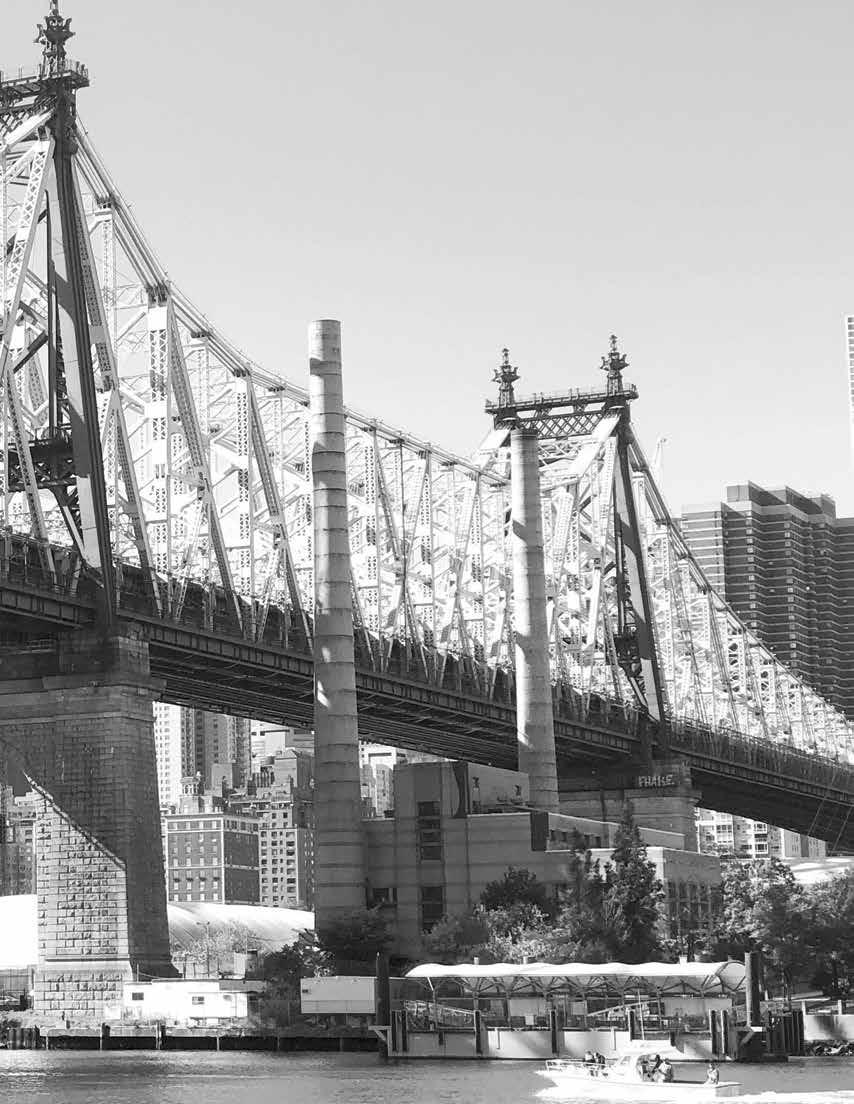

The project includes the replacement of the existing concrete grid deck with a new steel orthotropic deck as well as new Fire Standpipe, Drainage and electrical systems.
“This bridge is a crucial link and we are replacing one single roadway lane at a time while maintaining traffic in the other three (3) adjacent upper roadway lanes,” said AB Vice President Kwadwo Osei-Akoto, whose jurisdiction is the NYC area, and where for the past 33 years, he has been associated with major bridge projects.
“We are used to that, but being in the heart of NYC, with very limited staging and storage areas, the biggest challenges are the significant logistical and access constraints, which are further complicated by the very limited number of lane closures allowed by NYCDOT.”
cont...
Summer 2023
The project is divided into four phases – each one being the complete removal of the existing concrete filled grid deck and replacement of a single lane with a new steel orthotropic deck. So far crews have replaced two of the four lanes. The new steel orthotropic deck is being fabricated in Pennsylvania, and is being trucked to the job site. In total, 396 individual deck panels will be connected to the existing steel superstructure. The installation calls for them to be splice bolted and field welded in place to create a new, lighter, more durable deck system, extending the service life of the bridge by more than 75 years.
Kwadwo Osei-Akoto, AB’s VP for the NYC area, says he is pleased with how the management team and crews are taking the various challenges in stride. At peak construction for Phase 1 and 2 there were close to 200 AB and subcontractor personnel on-site. For each phase of the Queensboro Bridge, AB can permanently shut down one lane and temporarily close an adjacent one during off-peak hours during the day and night. The equipment needed to complete this work requires multiple lane closures to complete the work before returning one of the lanes to NYC traffic. Essential to the success of the project is state-of-the-art equipment, and AB is utilizing two custom designed overhead crane gantries and automatic welding machines to field weld all of the deck joint splices.
“Designing the gantry cranes was a big challenge, but they are working really well. They move about on a rubber tire system, and can move both longitudinally and transversely to set the panels in their exact location. It’s very tough to move them, along with


20 CONNECTIONS
“This bridge is a crucial link and we’re replacing a deck while maintaining traffic,” said AB Vice President Kwadwo Osei-Akoto.
“
Field welding of transverse joints for new orthotropic deck panels.
Bolting up field splice plates for new orthotropic deck
the other equipment, but we found solutions” said Kitty DiFalco, Senior Field Engineer on the project.
“We placed a concrete barrier along the entire length of the lane to separate our work area, and to protect the workers. When we get the extra lane, you have to do everything possible in the time you have before returning it to traffic. You have to stage your trucks and deliveries, get your equipment and get your crews to work fast and efficiently, to return the lane to traffic before ‘peak’ hours,” said Adam Reichard, Project Engineer on the project.
In addition to traffic, the logistical demands of bringing oversized materials and equipment in out of the work site, and operating equipment in tight spaces are challenging.
‘We work closely with NYCDOT regarding street closure notifications, and have brought in local permitting specialists that run daily traffic simulations, ensuring oversized truck loads can safely navigate the tight city streets,” said Andre Markarian,
Project Manager. “Once the panels arrive in the lane, it takes a few hours to erect them and bolt them down. We have very good operators and ironworkers that make this work look easy.”
The project team, with the assistance of AB’s in-house engineering department, has combed through thousands of asbuilt records to recreate the bridge loading models, and analyze the unique member demands imposed by cranes, trucks, and gantries.
While analyzing the existing members for adequate structural capacity, it was essential that a detailed as-built be developed by locating the precise locations of existing members and rivets, as the new orthotropic deck connections rely on the existing bridge superstructure to connect to. This was achieved by performing a 3D scan of the existing bridge, using cutting edge technology to process millions of raw survey data points, into a usable format, to incorporate the as-built dimensions into the new steel shop drawings. While previous AB projects have made use of 3D

21 Summer 2023 cont...
Installation of new orthotropic deck panel in Stage 1.
scans, they were not as detailed. The scan data was used to ensure that all of the newly fabricated steel could be connected to the existing structure. “Over half of the deck panels have been installed to date without any fit-up issues. It fit like a glove,” said Mike Mejaki, Project Engineer.

After the deck panels are erected and bolted to the existing structure, nearly 3 miles of field welding is required to splice the 396 individual orthotropic deck panels together. AB employed highly skilled welders and inspectors to ensure that all of the complete joint penetration (CJP) welds are completed to the highest quality standards, and meet all applicable NYCDOT specifications and project requirements. “Field welding deck plates is not an easy job, and requires personnel working on their hands and knees for weeks at a time to prepare, weld, grind and inspect the joints” says Mathew Balog, a Senior Field Engineer and Certified Welding Inspector responsible for overseeing the welding scope of work.
“The AB team assigned to the project brings together both industry veterans with invaluable experience and insight and recently hired college graduates willing and able to gain experience through the hands-on process of rebuilding America’s ageing infrastructure,” said Osei-Akoto.
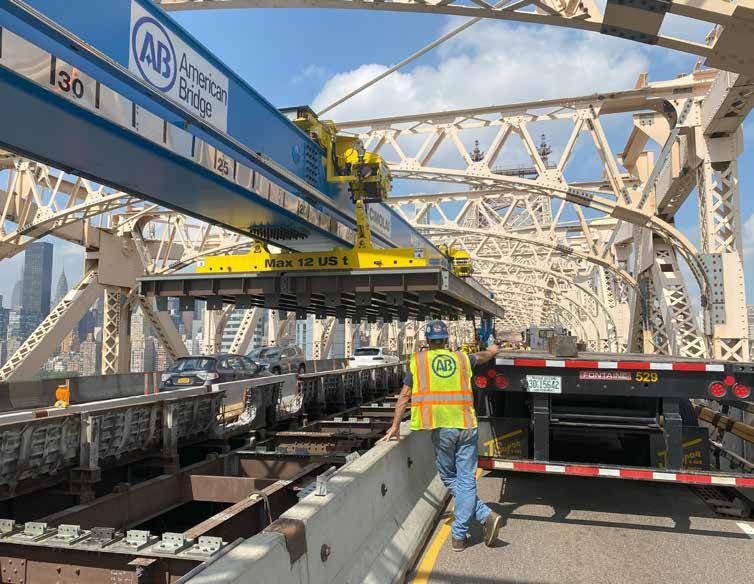
CONNECTIONS
22
Gantry crane erecting a new orthotropic deck panel in Stage 2 between traffic lanes.
INFRASTRUCTURE
The Infrastructure Investment and Jobs Act (IIJA), known as the Bipartisan Infrastructure Bill, is a United States federal statute enacted by the 117th United States Congress, and signed into law by President Joe Biden on November 15, 2021. The final version of the bill included $1.2 trillion in spending, $550 billion of which was newly authorized on top of funding normal authorizations.
What does this mean for the construction industry and Southland, and how can it address the $13 trillion infrastructure need identified by the American Society of Civil Engineers between now and 2039?
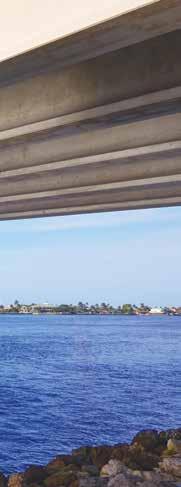



Investment Jobs Act
Summer 2023
cont... 23
This is a unique time in the construction market with generational investments being made across sectors.
The IIJA provides much-needed funding for critical infrastructure projects including specific allocations for:
FUNDING & CONSTRUCTION DEMAND
$85.46 billion for drinking water state revolving funds (SRF). $15 billion for lead service line replacement, and $9 billion to address PFAS also known as “forever chemicals,” which are a growing water supply concern.
Passed a year and a half ago, the Infrastructure Investment and Jobs Act (IIJA), combined with the Inflation Reduction Act of 2022 (IRA) has funded thousands of projects, with many more still to come.
Created two new programs to fund bridges. 1) $212.5 billion over 5 years for the Bridge Formula Program (BFP) to rehabilitate and replace bridges identified as “poor” or “fair” condition. 2) $12.5 billion over 5 years for the Bridge Investment Program (BIP) for competitive grants to replace, rehabilitate, preserve, or make resiliency improvements to bridges with over half the funds focused on large bridges (>$100 million).
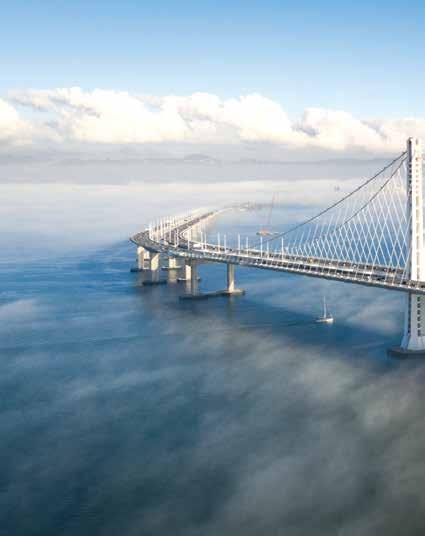
Shortly after the IIJA, the United States Army Corps of Engineers (USACE) authorized billions of dollars through the Water Resource Development Act (WRDA) in December 2022. WRDA 2022 authorized $30.4 billion in federal funds for 25 new USACE projects. Accounting for non-federal funding, Engineering NewsRecord (ENR) estimates that these 25 projects will cost $51.6 billion.
$350 million for highway rehabilitation and expansion over a 5-year period, providing the largest year-to-year increase in federal highway investment since the late 1950s. ARTBA economists utilize federal and state data to quantify the highway, bridge and safety improvements underway that include this landmark measure.
WATER BRIDGES HIGHWAY BROADBAND
$64 billion for upgrades to rail stations that were built before the Americans with Disabilities Act of 1990 was enacted to improve access to transit.
24 CONNECTIONS
PROJECTED FEDERAL SPENDING FROM IIJA & IRA
NOTE: Projected spending includes advance appropriations, budget impacts of IRA tax credits as estimated by the CBO, and a small number of authorized programs.
SOURCE: Brookings analysis of Infrastructure Investment and Jobs Act, Inflation Reduction Act, and CBO data.
Graphic Content: The Brookings Institute
The largest project authorized in WRDA 2022 is a Texas Gulf Coast hurricane protection system, sometimes referred to colloquially as the “Ike Dike”. The $21.4 billion federal allocation represents over 60% of the cost of the $34.4 billion program. A significant portion of the project includes movable flood gates, pump stations, and floodwalls that Southland is well qualified to participate in with American Bridge, Johnson Brothers, Southland Contracting and Oscar Renda Contracting expertise.
This is a unique time in the construction market with generational investments being made across sectors. Southland is well positioned to capture the uptick in spending across these markets, particularly for bridges and water system improvements with existing and new clients across the US. Even outside of the US market, Southland has seen strong infrastructure spending across Canada, but particularly in Ontario and the Toronto metro area.
Even after this act, the funding gaps identified by ASCE will require ongoing investments to maintain and replace existing infrastructure, as well as fund new infrastructure in the rapidly growing Sun Belt states. The infrastructure construction market is poised for a strong finish to the 2020s and onward into the 2030s.
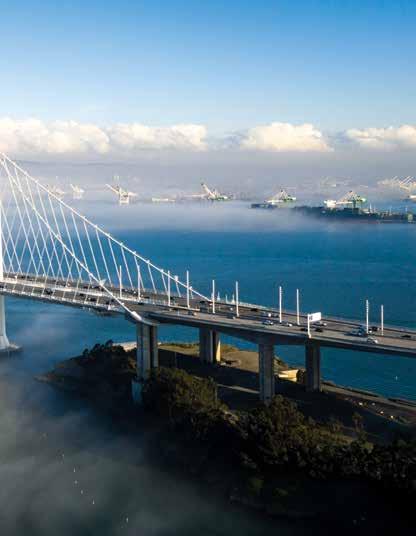
25 Summer 2023
$0 $100 $200 $300 $400 $500 $600 $700 Transportation Energy Utilites Water | Broadband Other Environmental Programs All Other IR A

26 CONNECTIONS
The First State-Of-The-Art Facility Of Its Kind In The Usa
innovation automation
Suntrax is a large-scale, state-of-the-art facility, dedicated to the research, development and testing of emerging transportation technologies, in safe, controlled environments.
The SunTrax Connected/Automated Vehicle Test Facility covers a vast area of 200 acres within a new Tolls Testing Facility, and features 11 miles of roadway infrastructure that can replicate different driving environments. It also contains 20 buildings on-site to support infield operations and maintenance, as well as a stormwater management system, to accommodate infield improvements.
The facility is specifically designed to test automated vehicles’ capabilities under various road conditions, obstacles, and traffic scenarios that simulate real-world driving conditions. The urban area offers intersection configurations and complex lighting, signing, and signalization conditions. The 20-acre open paved technology pad can replicate nearly any real-world geometric configuration, and perform endless test scenarios. The roadway geometry track has complex horizontal and vertical curves, plus irregular grade changes. Finally, the pick-up/drop-off area can mimic various multimodal passenger transfers, such as airports and transit centers.
Overall, the SunTrax Connected/Automated Vehicle Test Facility, provides a challenging environment for testing connected and autonomous vehicles (CAV) and emerging technologies. It is an ideal location for testing the latest technologies in a safe and controlled environment, offering a connected environment for testing vehicle-to-infrastructure (V2I), vehicle-to-vehicle (V2V), and vehicle-to-anything (V2X) communications.
OVERCOMING CHALLENGES
During the design phase, we initially estimated that the design of the SunTrax Infield, also known as “Phase 2”, would require 24 months. However, we were forced to reduce that timeline to just 15 months due to market conditions. To accomplish this, we had to put together four simultaneous building design teams, and separate civil/utility and roadway design teams. This was no small feat, considering the fact that we were designing a project for an ultimate user, “the operator”, who had yet to be defined.
27 Summer 2023
cont...
During the construction of the SunTrax Connected/Automated Vehicle Test Facility, the team encountered some significant challenges, especially with the impact of the unprecedented COVID pandemic.
However, with persistence & determination, alternative material suppliers were found to ensure the project’s success. The owner’s implementation of an incentive/disincentive program also played an essential role in motivating the team to meet the project’s full incentive date, showcasing the power of collaboration and the resilience of the human spirit, in the face of adversity.

The owner maintains and constructs toll roadway facilities across the state. However, building an 18-building campus with unique features like electronic interconnection, full underground utilities, and non-standard roadway test tracks, was not part of their regular work. Their biggest challenge was designing SunTrax to seem like a roadway in every aspect, including construction documents, design processes, specifications, and construction services.
It is important to note that the owner and the contracting teams they hire, do not usually build buildings. In the case of SunTrax, nearly half of the project funds went towards nonroadway construction, which was primarily the 18 buildings. This created a need for the contracting team to adapt to the unique requirements of the “FTE way” of doing business - which is quite different from their usual building customers.
For the arrival and conference center, several unique and innovative design features required close collaboration between the contractor, supplier, designer, and owner. One of the most notable of these was the custom-built roof covering, which required ongoing discussions and adjustments to ensure that the final product met the intended specifications, while maintaining its distinctive appearance.
When the designers developed the plans for the site, they wanted to make sure that it accurately replicated real-world driving conditions. We sought specialists and employed custom means and methods to ensure our roadways were imperfect. It was a lot of work, but we’re confident that the end result was worth it.
SAFETY
Many companies have safety plans that are only pulled out for a show. However, Suntrax’s management has displayed an unyielding will to follow through with their safety policy time and
time again. This has instilled a culture of safety throughout the company and has led to higher standards of vigilance among crew members even after they move on to other projects. Enforcing the basics and combating complacency from the top down is crucial for preventing employee injuries, and Suntrax’s success in this area cannot be overstated.
INNOVATION
This project embodied the definition of partnership and innovation. It opened up new ways to improve the way a project should be executed from concept to completion. Keeping all parties involved with respect for the priorities of others, throughout all the challenges of the project.
This project was also a first of its kind for a public entity. The State has not performed a project with this complexity in prior years and also incorporated a Silver certification under the Florida Green Building Coalition (FGBC) Florida Green Commercial Building Certification Standard (v2). The project team developed matrices, tracking, and inspection processes that will allow the owner to utilize these techniques in future projects.
28 CONNECTIONS
AWARDS & RECOGNITION
“BEST IN CONSTRUCTION AWARD” SPECIAL SIGNIFICANCE - 2022 Florida Transportation Builders’ Association (FTBA)
“JOHN W. BARR TRANSPORTATION ACHIEVEMENT AWARD” – 2021
FLPRITE (Florida Puerto Rico District of the Institute of Transportation Engineers)
“PRESIDENT’S AWARD FOR EXCELLENCE” – 2020 International Bridge, Tunnel, and Turnpike Association (IBTTA)

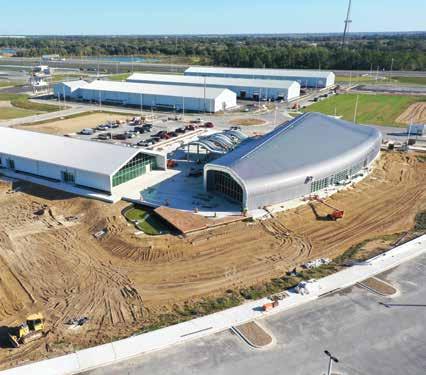
“BEST USE OF TECHNOLOGY & INNOVATION” – 2020 America’s Transportation Award (Southern Association of State Highway and Transportation Officials (SASHTO))

29 Summer 2023
We sought specialists and employed custom means and methods to ensure our roadways were imperfect.
Brent Spence Bridge
completed using a balanced cantilever method on the river piers which allowed the shipping channel to remain free of additional falsework.

Historic Project Look back
The Brent Spence Bridge, located in the Cincinnati-Northern Kentucky metropolitan area, is a double-decker, cantilevered truss bridge, that spans the Ohio River, carrying interstates 71 and 75 with more than 160,000 vehicles crossing each day. Named after Congressman Brent Spence, Kentucky’s longest-serving congressman at the time, it was constructed by American Bridge (AB) in 1963 and remains a vital transportation link for the region. However, the construction of this iconic bridge was not without its challenges.
The bridge’s location was one of the biggest challenges AB faced during the construction. The bridge had to be built on the Ohio River, which required careful planning and coordination to ensure the safety of workers and materials. The river also presented logistical challenges for transporting materials to the site.
The AB engineering team designed and utilized a cantilever construction method to overcome these challenges in order to build the bridge. This involved constructing each end of the bridge and then joining them in the middle.The construction was
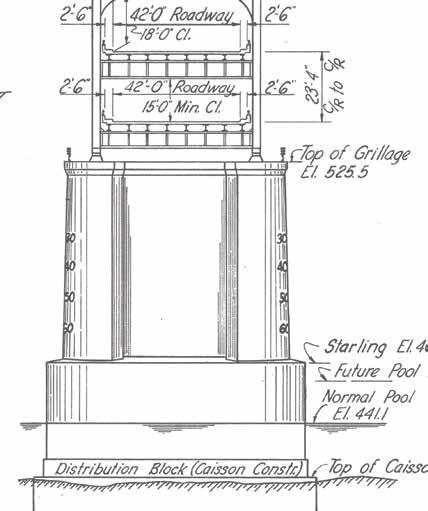
Another challenge AB faced during the construction of the Brent Spence Bridge, was the design of the bridge itself. The bridge design completed by Modjeski and Masters, had to be designed to accommodate a large amount of traffic, while also being strong enough to withstand the forces of nature. The design of the Bridge incorporated innovative engineering techniques, such as posttensioning to strengthen the bridge’s structure, and enhance its durability. Post-tensioning is a technique that involves applying tension to steel cables or bars after they have been embedded in concrete. This technique was used to reinforce the bridge’s concrete deck, which helped to increase its strength and reduce the likelihood of cracking.
The Brent Spence Bridge was also one of the first bridges of its kind to use a composite steel and concrete deck. This type of deck consists of steel beams and a concrete slab connected to form
30
a single, integrated unit. The steel beams provide the structural support for the deck, while the concrete slab serves as the driving surface for vehicles.
Using a composite steel and concrete deck presented several challenges for the AB team during the bridge’s construction. For example, the steel beams had to be accurately positioned to ensure that they would properly support the concrete deck. Additionally, the concrete had to be poured and cured correctly to ensure it would bond properly to the steel beams and remain durable over time.
Despite many challenges, American Bridge successfully constructed the Brent Spence Bridge on schedule. The bridge opened to traffic in November 1963 and has since become an iconic structure for the region, and nationally as an example of the country’s infrastructure needs. Over the years, the bridge has required several repairs and renovations to maintain its safety and functionality. A new $3.6 Billion bridge will be constructed alongside the original, utilizing funds from the Infrastructure Investment and Jobs Act (IIJA).
Despite the planned construction of a new bridge, the original Brent Spence Bridge remains an essential piece of infrastructure

for the region. Its composite steel and concrete deck, posttensioning, and innovative engineering techniques, are a testament to American Bridge’s expertise and capabilities.
On Nov. 11, 2020, a trucking accident on the Brent Spence Bridge caused a fire that damaged the bridge’s upper deck floor system steel, drainage, deck, barriers, electrical components and the lower deck’s overlay. The bridge reopened just 41 days after the accident, with the project finishing under budget and ahead of schedule.
The bridge has played a crucial role in connecting two states and supporting economic growth, and it will continue to do so for many years to come.
The Brent Spence Bridge was also one of the first bridges of its kind to use a composite steel and concrete deck.
31 Summer 2023
The construction industry observed Safety Week 2023 on May 1-5. This year’s theme was “Strong Voices, Safe Choices.”


Throughout the week, discussions occurred across Southland and American Bridge staff and craft, with the goal of maintaining a strong safety culture through open and honest dialogue. Safety is the foundation of our “Protect My Family” culture, and is fundamental to ensuring everyone goes home safely every day. Leaders and workers must back each other up and make Safe Choices.
meet the DIRECTORS
As the safety directors for Southland, these gentlemen work tirelessly with our teams to educate, mentor, recognize, and oversee all aspects of our safety programs.
DAN


Safety Director, 25 years of experience in the industry, and 17 years with SLND.


Email Dan: dyanes@ southlandholdings.com
Safety Director, 22 years of experience in the industry and 18 years with SLND.



Email Jesse: Jesse@ southlandholdings.com
Safety Director, 19 years of industry experience and 9 years with SLND.
Email Justin: chogan@ southlandholdings.com
Safety Director, 24 Years experience and 6 years with SLND.
Email Quinn: QBurgess@ southlandholdings.com
Safety Director, 20 Years experience, and 3 Years with AB.
Email Shaun: SBurke@ americanbridge.net
PROTECT MY FAMILY
CONNECTIONS
SR520, Seattle Washington
YANES : ORC
JUSTIN HOGAN : JBC
SHAUN BURKE : AB
JESSE ESCAMILLA : SCI
QUINN BURGESS : HAC
32
When it comes to mental health conditions, studies show that the construction industry has one of the highest suicide rates by population for males.

In fact, the suicide rate for the construction industry is roughly four times the national average, and more construction workers die from suicide each year than every other workplace-related fatality combined. This is largely due to factors such as working in a highstress, deadline-driven environment, long work hours, seasonal workload, and separation from family when working away from home. The biggest cause, however, is that individuals who are struggling are doing it in silence. In male-dominated industries, strength and toughness are often highly valued, and admitting that you need help is unjustly viewed as weak; this means that people who need help often won’t seek it.

Dealing with depression and or anxiety is challenging but does not need to be managed alone. We naturally seek out help with a broken limb, or the flu, yet shy away from seeking out help when struggling with anxiety or depression. The stigma surrounding mental health in the construction industry has devastating impacts on those in our field, and we never want to see a member of the Southland family struggling.
All Southland employees have access to the Employee Assistance Program (EAP). The EAP provides a variety of professional services to help improve mental health, reduce stress, and make life easier. For more information, contact HR or visit http://rsli.acieap.com


33 Summer 2023 NATIONAL SUICIDE PREVENTION LIFELINE: CALL OR TEXT 988
w
SouthlandHoldings.com southlandholdings.com/ company/american-bridge-company Southland Holdings @onlinesouthland @AmericanBridge @southlandholdings @american_bridge_company Southland Holdings americanbridge.net Get involved! submit your BEST SHOT for pic of the week marketing@southlandholdings.com Follow Us!
SOCIAL
“PROTECT MY FAMILY” An ATTA-BOY Story
It’s not everyday that you meet a guardian angel. Someone who just shows up and helps unexpectedly right when you need it most.
Yet this is exactly what happened to Aimee Theisen while driving home to Baton Rouge, Louisiana from Houston with her 2 young nieces. They were making their way home from the Taylor Swift concert which they had gone to see the night before, when they unexpectedly hit a pothole that had formed at a seam in the construction zone on I-10 near Beaumont, causing an immediate blowout. Fortunately they were able to make it safely off the interstate to the Ben J. Rogers Visitors Center, before the tire went completely flat.
Aimee recounted the following in a letter. “I’m small, but pretty self-sufficient, I can change a tire, easily. Except that this particular Saturday morning just before 11am, I could not for the life of me crack the dang lugs to get the tire off. With all our bags pulled out of the trunk and scattered around, 2 young girls becoming antsy, me beginning to worry (and trying to hide it from them), one of your employees showed up out of nowhere and changed my flat tire. I keep comparing it to the cornfield scenes in Field of
Dreams …, he appeared from seemingly nowhere and left in the same fashion. I never saw him coming or going – he was just there – exactly when we needed him.”

She further explained that she only had a few $1 bills, but that he would not accept them. “I was able to track down project info on the TX DOT project tracker. One of my nieces snapped a quick pic of him working on the tire (for Instagram, go figure) and the logo on his safety vest

matches the JOHNSON BROS. CORPORATION, A SOUTHLAND COMPANY logo from the website. That logo… “PROTECT MY FAMILY”… wow. I get emotional thinking about the endless possible outcomes of that day, of that single event. But this man, your selfless employee, protected my family. He saved us. And I’m so thankful.”
This selfless and caring man was our very own Javier Garza , whom we commend and thank. It is this type of behavior that epitomizes the “Protect My Family” ethos.
34 CONNECTIONS
PLEASE SUBMIT YOUR STORIES TO US! marketing@southlandholdings.com blessings the SOUTHLAND way




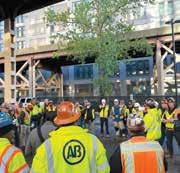












 Safety week at Table Rock Lake Project in Missouri
Safety week at Queensboro Project in New York
Members of Southland at the NYSE
Janie Rodriguez recieves patriot award for veteran support. Ashbridges Way: Johnson Bros. Marine work in Lake Ontario.
Co-Op interns aiding Queensboro Bridge construction.
AB Superintendents learning and growning in Pittsburgh.
JBC team achieves successful bridge deck pour in Orlando
Ashbridges Bay Tunnel team: One million safe work hours.
Romeo Arm Lining Seg. 5 Project: Captured by Dell Adams.
AB team working on the Disney Cruiselines Bahamas Project
Neil Napolitano guides group on operational improvment.
Mill Creek Tunnel, first CIP segment pour.
Go Frogs! Coach Sonny Dykes delivers inspiring talk @ Managers Meeting
Rudy Renda dominates the bocce ball court.
Over 100 gift bags packed in trailer for children’s Christmas.
Night at the ballpark with some DFW team members.
SELA team celebrates milestone with crawfish boil.
Safety week at Table Rock Lake Project in Missouri
Safety week at Queensboro Project in New York
Members of Southland at the NYSE
Janie Rodriguez recieves patriot award for veteran support. Ashbridges Way: Johnson Bros. Marine work in Lake Ontario.
Co-Op interns aiding Queensboro Bridge construction.
AB Superintendents learning and growning in Pittsburgh.
JBC team achieves successful bridge deck pour in Orlando
Ashbridges Bay Tunnel team: One million safe work hours.
Romeo Arm Lining Seg. 5 Project: Captured by Dell Adams.
AB team working on the Disney Cruiselines Bahamas Project
Neil Napolitano guides group on operational improvment.
Mill Creek Tunnel, first CIP segment pour.
Go Frogs! Coach Sonny Dykes delivers inspiring talk @ Managers Meeting
Rudy Renda dominates the bocce ball court.
Over 100 gift bags packed in trailer for children’s Christmas.
Night at the ballpark with some DFW team members.
SELA team celebrates milestone with crawfish boil.

1100 Kubota Drive, Grapevine, TX 76051 United States of America www.southlandholdings.com Southland Contracting, Inc. | American Bridge Company | Oscar Renda Contracting, Inc. Johnson Bros. Corporation | Mole Construction | Heritage Materials Copyright 2023 Southland Holdings LLC


















































































 Safety week at Table Rock Lake Project in Missouri
Safety week at Queensboro Project in New York
Members of Southland at the NYSE
Janie Rodriguez recieves patriot award for veteran support. Ashbridges Way: Johnson Bros. Marine work in Lake Ontario.
Co-Op interns aiding Queensboro Bridge construction.
AB Superintendents learning and growning in Pittsburgh.
JBC team achieves successful bridge deck pour in Orlando
Ashbridges Bay Tunnel team: One million safe work hours.
Romeo Arm Lining Seg. 5 Project: Captured by Dell Adams.
AB team working on the Disney Cruiselines Bahamas Project
Neil Napolitano guides group on operational improvment.
Mill Creek Tunnel, first CIP segment pour.
Go Frogs! Coach Sonny Dykes delivers inspiring talk @ Managers Meeting
Rudy Renda dominates the bocce ball court.
Over 100 gift bags packed in trailer for children’s Christmas.
Night at the ballpark with some DFW team members.
SELA team celebrates milestone with crawfish boil.
Safety week at Table Rock Lake Project in Missouri
Safety week at Queensboro Project in New York
Members of Southland at the NYSE
Janie Rodriguez recieves patriot award for veteran support. Ashbridges Way: Johnson Bros. Marine work in Lake Ontario.
Co-Op interns aiding Queensboro Bridge construction.
AB Superintendents learning and growning in Pittsburgh.
JBC team achieves successful bridge deck pour in Orlando
Ashbridges Bay Tunnel team: One million safe work hours.
Romeo Arm Lining Seg. 5 Project: Captured by Dell Adams.
AB team working on the Disney Cruiselines Bahamas Project
Neil Napolitano guides group on operational improvment.
Mill Creek Tunnel, first CIP segment pour.
Go Frogs! Coach Sonny Dykes delivers inspiring talk @ Managers Meeting
Rudy Renda dominates the bocce ball court.
Over 100 gift bags packed in trailer for children’s Christmas.
Night at the ballpark with some DFW team members.
SELA team celebrates milestone with crawfish boil.
